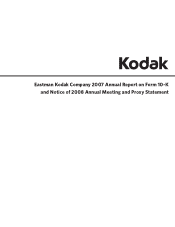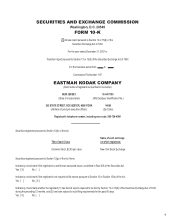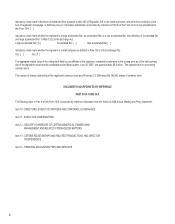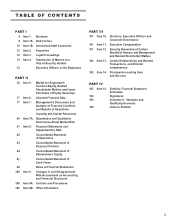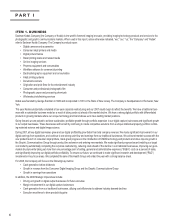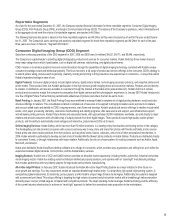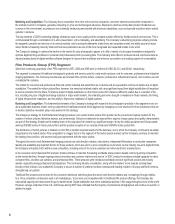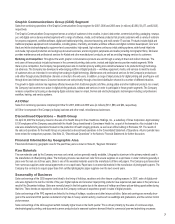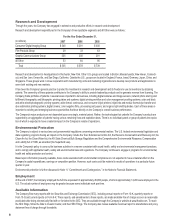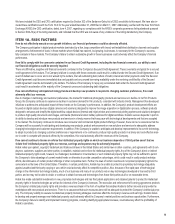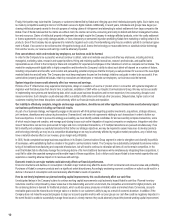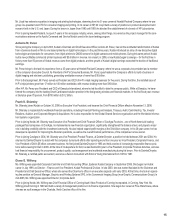Kodak 2007 Annual Report Download - page 7
Download and view the complete annual report
Please find page 7 of the 2007 Kodak annual report below. You can navigate through the pages in the report by either clicking on the pages listed below, or by using the keyword search tool below to find specific information within the annual report.6
Marketing and Competition: The Company faces competition from other online service companies, consumer electronics and printer companies in
the markets in which it competes, generally competing on price and technological advances. Rapid price declines shortly after product introduction are
common in this environment, as producers are continually introducing new models with enhanced capabilities, such as improved resolution and/or optical
systems in cameras.
The key elements of CDG’s marketing strategy emphasize ease of use, quality and the complete solution offered by Kodak products and services. This is
communicated through a combination of in-store presentation, online marketing, and advertising. The Company’s advertising programs actively promote
the segment’s products and services in its various markets, and its principal trademarks, trade dress, and corporate symbol are widely used and recog-
nized. Kodak is frequently noted by trade and business publications as one of the most recognized and respected brands in the world.
The Company’s strategy to address the decline in the market for color photographic papers is to offer a variety of color paper formulations designed to
optimize digital printing workflows in consumer and professional photo processing labs. The Company also offers to professional and commercial labs an
industry-leading family of digital workflow software designed to improve their workflows and enhance our position as a leading supplier of consumables.
Film Products Group (FPG) Segment
Sales from continuing operations of the FPG segment for 2007, 2006 and 2005 were (in millions) $1,968, $2,312, and $2,841, respectively.
This segment is composed of traditional photographic products and services used to create motion pictures, and for consumer, professional and industrial
imaging applications. The Company manufactures and markets films (motion picture, consumer, professional, industrial and aerial), and one-time-use and
re-loadable film cameras.
The market for consumer and professional films and certain industrial and aerial films are in decline and are expected to continue to decline due to digital
substitution. The market for motion picture films, however, has remained relatively stable, with any significant impact from digital substitution still expected
to evolve sometime into the future. The future impact of digital substitution on the motion picture film market is difficult to predict due to a number of fac-
tors, including the pace of digital technology adoption in major world markets, the underlying economic strength or weakness in these markets, the timing
of digital infrastructure installation, and the ability to finance the installation of digital systems.
Marketing and Competition: The fundamental elements of the Company’s strategy with respect to the photographic products in this segment are to cre-
ate a sustainable business model, serving customers for traditional products while aggressively managing our cost structure for those businesses that are
in decline. Selective innovation plays a key element in this strategy.
The Company’s strategy for the Entertainment Imaging business is to sustain motion picture film’s position as the pre-eminent capture medium for the
creation of motion pictures, television dramas, and commercials. Selective investments to improve film’s superior image capture and quality characteristics
are part of this strategy. Kodak has the leading share of the origination film market by a significant margin, led by the widely-acclaimed and Oscar-award-
winning VISION2 series of motion picture films and the positive reception of our recently introduced VISION3 motion picture film.
The distribution of motion pictures to theaters on print film is another important element of the business, one in which the Company continues to be widely
recognized as the market leader. Price competition is a bigger factor in this segment of the motion picture market, but the Company continues to maintain
the leading share position, with several multi-year agreements with the major studios.
Throughout the world, most Entertainment Imaging products are sold directly to studios, laboratories, independent filmmakers or production companies.
Quality and availability are important factors for these products, which are sold in a price competitive environment. As the industry moves to digital formats,
the Company anticipates that it will face new competitors, including some of its current customers and other electronics manufacturers.
In the consumer and professional film markets, Kodak continues to maintain the leading worldwide share position despite continuing strong competition
as the market declines, through ongoing product innovation and customer relations and service. In 2007, product innovations included upgrades to select
consumer films, one-time-use cameras, and professional films. These products were introduced worldwide and won significant acclaim and industry
awards, especially among professional photographers. The continuing industry consolidation, along with the retailers’ move towards carrying fewer
brands on their shelves, has enabled the Company to secure a number of preferred contract renewals with leading retailers in Europe and North America,
strengthening our position.
Traditional film products and services for the consumer market are sold throughout the world, both direct to retailers and, increasingly, through distribu-
tors. Price competition continues to exist in all marketplaces. To be more cost competitive with its traditional film product offerings, the Company has
rationalized capacity and restructured its go-to-market model. Digital substitution has led to substantial declines in film usage throughout most of the world.
However, surveys conducted in the U.S. and Europe during 2007 have indicated that the majority of professional photographers will continue to use film, in
addition to digital.

